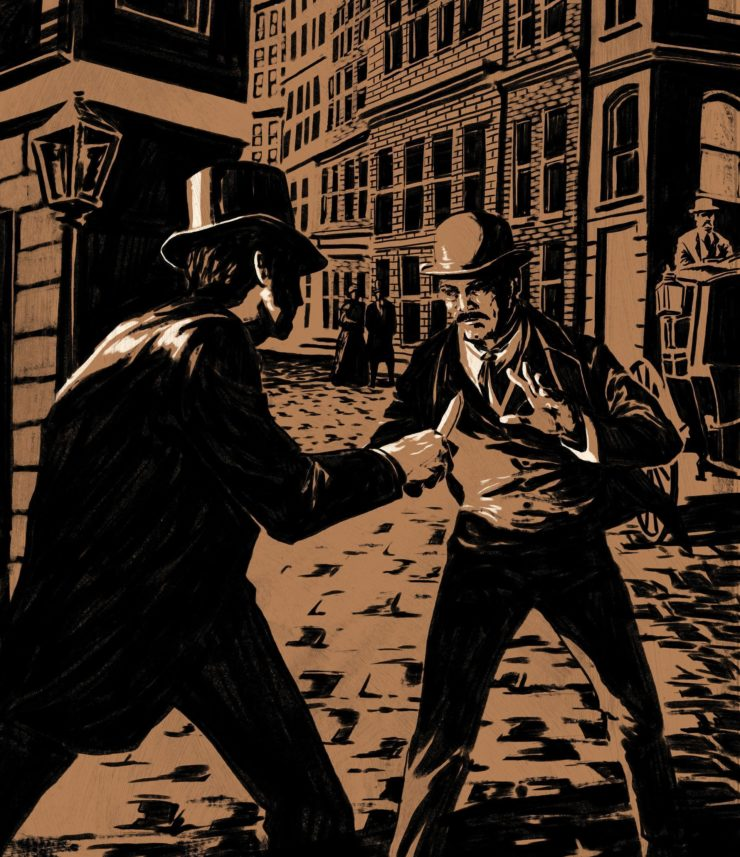This week on Storyboard we spotlighted two pieces of historical nonfiction, with one telling the story of America’s first detectives, back in the time of Charles Dickens, and the other reaching back just 40 years, to the brutal Argentine dictatorship that saw thousands of people “disappeared” and their children given to other families. As writer Matthew Pearl says of this kind of writing: “It’s a primal form of storytelling: ‘Let me tell you what happened right on this spot a long time ago.’” Or not so long ago, as the case may be.
Matthew Pearl and “Into the Shadows” (Filed under: You can’t make this stuff up). This is an epic annotation of Pearl’s story about America’s first detectives — a story that, amazingly, hadn’t been told before. I love Julia Shipley’s introduction to her free-ranging discussion with the novelist-slash-nonfiction-writer: How far will Pearl go to satisfy his curiosity or verify a hunch? How does he sidestep sketchy holes in the narrative? Among other thoughtful answers in the annotation, Pearl points to the underexploited opportunity of historical longform, eulogizes his time wasted hunting archives for the letter “R,” and describes the counterintuitive freedom he feels writing true stories. “It’s like a free pass,” the novelist confesses with relief. “It happened!”
The soundtrack: “Watching the Detectives,” by Elvis Costello. Oh my God, the layering of sounds in just the first few seconds: the spooky bassline, the plucked guitar, and then the sinister lead guitar — joined later by the oddly jaunty keyboards. The music and the tremendous lyrics make this one of his best songs.
One Great Sentence
“NOVEMBER, noun. The eleventh twelfth of a weariness.”
Ambrose Bierce, “The Devil’s Dictionary,” 1911. Read why we think it’s great.
Bridget Huber and “The Living Disappeared” of Argentina. As contributor Alexa Mencia says in her lede to this interview: “Huber turns the complicated, still-unfolding story of the missing children from Argentina’s military dictatorship into a relatable narrative about loss.” In the interview, Huber talks about the long gestation period for her story about a woman who searched for nearly four decades for her grandson, who had been born in a torture camp and given away at birth: “If you’re really gripped by something and you keep coming back to it over and over again, maybe there’s a reason there. And maybe it’s something to continue to follow, even if it doesn’t seem to make a whole lot of logical sense.”
The soundtrack: “Truth,” by Balmorhea. Back when I used to edit a lot of longform about pain and war and sorrow, this is the band I gravitated toward. I usually listen to music with lyrics, but Balmorhea’s instrumentals strike a musical chord deep within me. I must have listened to this live album a hundred times.
What I’m reading online: “Trapped: The Grenfell Tower Story,” by Tom Lamont. This GQ piece is a very good reconstruction of the night of the fire, with spooky details like “Talabi could see inexplicable and contradictory things. Smoke from below. Fire from above. Fire falling from above, making a tsk-tsk-tsk sound as great glowing slices of something peeled away from Grenfell’s stricken upper floors and dropped past his kitchen window.” But Lamont also weaves in the context of London’s breakneck boom, which is changing the face of the beautiful city: “The city has been seized by a glib, unabashed, and apparently unstoppable will to build.”
“Unholy Act,” by Pamela Colloff. This week, Colloff tweeted a long (and wonderful) thread about this 12-year-old Texas Monthly story as the priest — the only suspect in the murder of a young woman more than half a century ago — finally went on trial for her killing. It’s a powerful piece that lays bare the impunity of abusive priests, even outside the Catholic Church.
Jay-Z and Dean Baquet. I was fascinated by this interview of the rap superstar by The New York Times editor. O.J. Simpson looms large in both their psyches — young black men growing up in an America where their hero tried to negate his own blackness. (I was a bit startled that neither of them mention the actual act that brought down their hero, referring only to “we know how that story plays out” and O.J.’s “trauma.”)
On a related note, Pulitzer winner John Branch tweeted out The New York Times’ rave review of Michael Jackson’s “Thriller” album, which came out 35 years ago. Wow. The idea of race and music plays a large role in the review: “It is as hopeful a sign as we have had yet that the destructive barriers that spring up regularly between white and black music – and between whites and blacks – in this culture may be breached once again.”
What’s on my bedside table: “Guard Your Daughters,” by Diana Tutton. I’ve already touted the pleasures of the Persephone Books series of reprints of out-of-publication books by (mostly) women writers of the mid-20th century. This one is a total comfort read a la “I Capture the Castle,” with a strong undercurrent of feminism beneath the coziness of the surface. It’s perfect for a cold day’s read in front of the fire in this #MeToo fall.
What’s on my turntable: “Armed Forces,” by Elvis Costello and the Attractions. After listening to “Watching the Detectives” (see above), I went on a little Elvis jag. I hadn’t listened to him in years, and although I never forget how brilliant a wordsmith he is, it’s wonderful to experience it firsthand again. Here’s a timely bit (written by Nick Lowe, another great songwriter): “As I walk through this wicked world/Searching for light in the darkness of insanity/I ask myself: Is all hope lost?/Is there only pain and hatred, and misery?/And each time I feel like this inside/There’s one thing I wanna know:/What’s so funny ’bout peace love and understanding?”
If you want to chat about storytelling (or music), I’m Storyboard editor Kari Howard, and you can reach me at editor@niemanstoryboard.org. Or you can find me at @karihow on Twitter.



